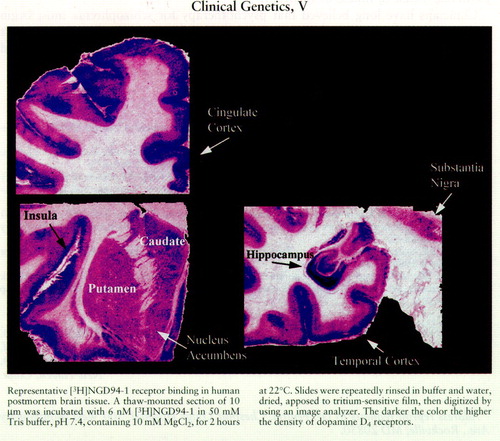Clinical Genetics, V : Association of Genetic and Personality Characteristics
While simple genetics is sufficient to explain heritability for some human characteristics, concepts of complex genetics are necessary to explain the heritable component of most behavioral characteristics and CNS diseases. One possible example of such complex heritability is “novelty-seeking” behavior (characterized by excitability and impulsiveness) and its recent association with one variant of the D4 dopamine receptor, the D4.7. The D4 receptor is a G-protein-coupled receptor in the D2 dopamine receptor family; it has certain structural features in common with the D2 and D3 receptors but has critical distinguishing structural and pharmacologic characteristics. Moreover, its distribution in human brain is distinctive, with the highest density in the neocortex, hippocampus, and entorhinal cortex (see figure); its density is lower in caudate and putamen, regions where D2 receptors are very dense. In addition, there exist approximately eight variants of the D4 receptor, which differ from each other in the number of amino acid repeats in the third intracytoplasmic loop. The D4.4 variant is found with the highest frequency (66%). The interesting distribution and variability have encouraged speculation about the function of the D4 receptor in human brain. Every person has two D4 receptor variants, one coded from each chromosome. They are detectable by using polymerase chain reaction (PCR) on a human blood sample. Two independent well-characterized human populations without psychiatric illness were analyzed for their D4 receptor isoforms. They were also typed with respect to normal personality characteristics. Their personality test scores were then associated with the presence of the D4 isoforms by using analysis of variance. The group of subjects with the longest variant, D4.7, scored higher on novelty seeking than did subjects with the shorter, D4.4, variant. A third study did not replicate this finding, although a tendency in that direction was seen. Additionally, it has been reported that in attention deficit/hyperactivity disorder (ADHD) the D4.7 variant occurs more frequently than the D4.4 variant. The distinctive functional characteristic that the D4.7 variant brings (excitability/impulsiveness) to the human brain is potentially a contributing substrate for novelty-seeking behaviors and ADHD. The biologic mechanism that mediates this association remains to be identified.
Address reprint requests to Dr. Tamminga, Maryland Psychiatric Research Center, P.O. Box 21247, Baltimore, MD 21228. Photograph courtesy of Dr. Robert Lahti.

Representative [3H]NGD94-1 receptor binding in human postmortem brain tissueA thaw-mounted section of 10 µm was incubated with 6 nM [3H]NGD94-1 in 50 mM Tris buffer, pH 7.4, containing 10 mM MgCl2, for 2 hours at 22°C. Slides were repeatedly rinsed in buffer and water, dried, apposed to tritium-sensitive film, then digitized by using an image analyzer. The darker the color the higher the density of dopamine D4 receptors.



